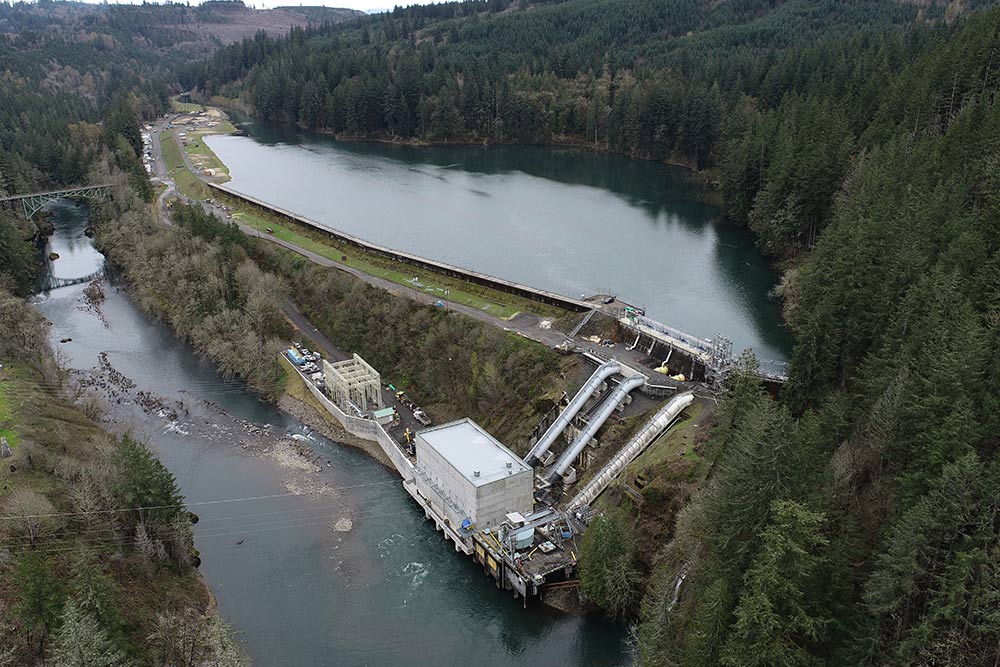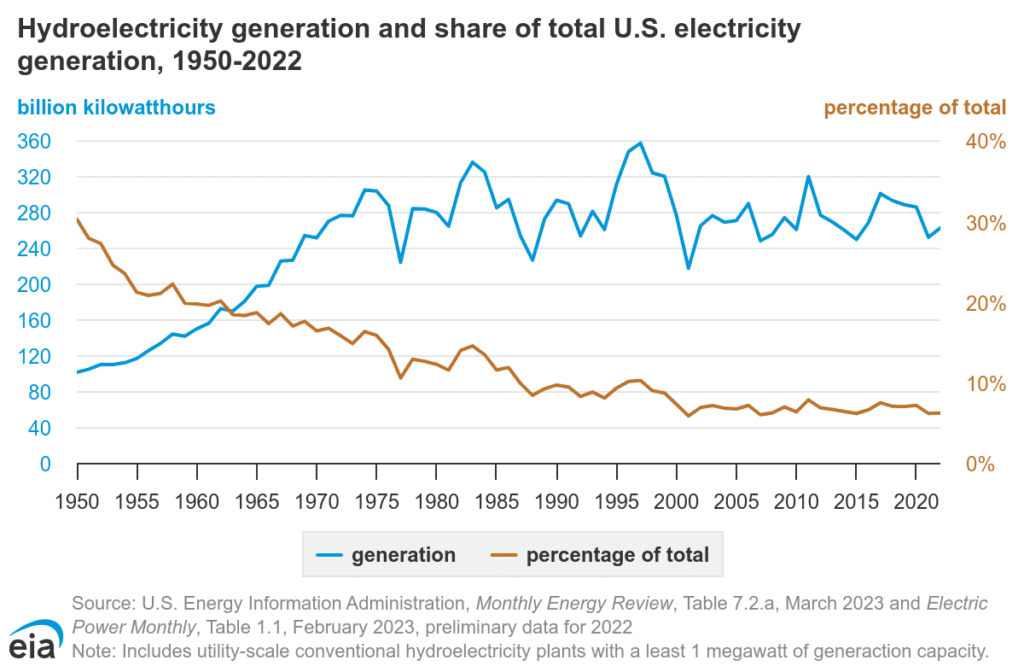DOE Injects $430M to Revitalize, Modernize U.S. Hydropower Fleet
The Department of Energy (DOE) has selected 293 hydroelectric projects across 33 states that will receive up to $430 million in incentive payments for capital improvements directly related to grid resiliency, dam safety, and environmental improvements.
The funding, unveiled on Sept. 5, stems from the DOE Grid Deployment Office’s (GDO’s) Maintaining and Enhancing Hydroelectricity Incentives program, for which the 2021-enacted Infrastructure Investment and Jobs Act (IIJA) allocates $553.6 million. The program is one of several hydropower incentive measures established by the Energy Policy Act of 2005 (EPAct) and is outlined in Section 247 of the law.
According to GDO Director Maria Robinson, the $430 million in federal funding, combined with private investment from each facility, will catalyze a total of $2.8 billion in investment in the nation’s hydroelectricity. “This will make critical capital improvements to our existing hydroelectricity facilities while also protecting existing hydroelectricity jobs, contractors, vendors, and largely, construction,” she told reporters on Wednesday.
A Focus on Grid Resilience, Dam Safety, and Environmental Impact Projects
The GDO said the 293 projects will use the funding to refurbish aging hydroelectric facilities, which have an average age of 79 years. At least 44 projects received the same level of funding—$5 million—and 128 projects received more than $1 million.
Table: Overview of hydroelectric projects funded under the DOE’s Maintaining and Enhancing Hydroelectricity Incentives program. This table presents a breakdown of funding allocations, project descriptions, and state distribution as unveiled by the DOE on Sept. 5.
“On average, the federal cost share per facility is roughly about $1.5 million, with an overall total capital improvement project cost per facility coming up to about $9.6 million. So, we’re really excited about this investment in the incredibly important hydroelectric fleet across this country, recognizing the important role that it plays in maintaining resilience on our electric grid,” said Robinson.
Several projects, such as the Bartlett’s Ferry Units 1-4 Generator Upgrade in Alabama and the Claytor Hydroelectric Project in Virginia, will seek to replace or upgrade turbines and generators, control systems, cables, transformers, and penstocks. Many selected projects, including the Mitchell Dam Spillway Gate Replacement in Alabama and the Prairie du Sac Spillway Tainter Gate Rehabilitation in Wisconsin, are dedicated to improving dam safety and strengthening existing infrastructure for resiliency against extreme weather events.
Other projects like the Pelton-Round Butte Dam Fish Trap and Hatchery Rearing Facility in Oregon and the York Haven Nature-Like Fishway in Pennsylvania will focus on environmental and recreational improvements to enhance water conditions and expand the surrounding habitat. These projects will, for example, install fish ladders and other equipment to facilitate aquatic species’ passage through dams and turbines, enhance wildlife habitats around dams, deploy special turbines to improve water quality and oxygen levels, boost aquatic habitats downstream, support species of conservation or cultural significance, and establish or maintain recreational facilities and opportunities near dams.
“We understand that those environmental improvements can be relatively costly, and so by utilizing these incentives programs provided through President Biden’s Bipartisan Infrastructure Law that will reduce the overall cost of capital,” Robinson said.
California facilities received the most incentives, with a combined $72 million allocated for 39 projects, followed by Washington State, which received approximately $48.6 million for 12 projects. Maine ranked third, with about $33.8 million allocated for 21 projects, while Michigan received $27.7 million for 19 projects, and South Carolina was awarded $27.6 million for 11 projects.

Aging Hydropower Fleet Is a Cause for Concern
While the projects selected under the Maintaining and Enhancing Hydroelectricity Incentives program are not expected to add significant new capacity, the DOE on Thursday said they are part of a comprehensive effort to modernize the U.S. hydropower fleet.
Hydropower currently generates 6.2% of total U.S. power—and 28.7% of its renewable power. That share has fallen dramatically over the past few decades owing to climate change impacts, uncertain water flows, high upfront capital costs for new development, and increasing competition from other renewables, like solar and wind. Another major challenge highlighted by the DOE is that aging facilities are becoming more expensive to maintain.

Hydropower projects “tend to be older, with only 3% of capacity coming online since 2000,” Lizzie Bonahoom, research associate at Aurora Energy Research, recently told POWER. “The three different types of large-scale hydropower across the U.S. are conventional hydropower [impoundment] at 79 GW, pumped storage at 22 GW, and run of river [hydrokinetic or diversion] at just under 1 GW. Over half [50 GW out of 79 GW] of existing conventional hydro is located in the West, particularly Washington, California, and Oregon, whereas, most pumped storage is located in the South [10 GW],” she said.
Bonahoom suggested new policy mechanisms could effect a shift in hydropower’s fortunes. “Different revenue streams and subsidy structures are available to new build hydropower projects across the U.S. All are supported by federal investment tax credits, which under IRA provisions could reach up to a 50% discount on total project CAPEX [capital expenditure]. Conventional hydropower and run of river are also eligible for the production tax credit, a variable subsidy based on electricity generation. Additional support is available for hydro in the Bipartisan Infrastructure Law, which aims to improve environmental standards and operation of existing facilities, without extending support to new facilities.”
| [For more on hydropower’s challenges, see POWER’s in-depth analysis from our July 2024 issue here: Hydropower Remains Renewable Leader Despite Climate Challenges.] |
The Latest in a Long List of Recent Hydropower Incentives
For its part, the DOE has acted purposefully to identify critical challenges. In October 2023, it released a “reimagined” Hydropower Vision Roadmap. Last updated in 2016, the document, now revamped as a “living document,” suggests that “with continued technology advancements, innovative market mechanisms, and a focus on environmental sustainability, U.S. hydropower could grow from its current 101 GW to nearly 150 GW of combined electricity generating and storage capacity by 2050.” The roadmap, notably, lays out the specific activities identified by the hydropower community to achieve those goals by 2050.
Separately, the DOE has taken notable actions on similar incentive programs in recent months. In October 2023, it unveiled 66 hydro facilities across the country under the Hydroelectric Production Incentive Program (EPAct Section 242) that will receive more than $36.7 million for electricity generated and sold during the calendar years 2021 and 2022. Nine of those recipients were eligible under inadequate electric service eligibility criteria. Additionally, the GDO issued application guidance for the 2023 incentives on March 14, 2024, with the application period closing on April 23, 2024. These applications are currently under review, the DOE says.
In February 2024, meanwhile, the DOE announced the selection of 46 hydroelectric projects across 19 states, allocating up to $71.5 million to these projects under the Hydroelectric Efficiency Improvement Incentives (EPAct Section 243). Investments under that program are slated to support the continued operation of the U.S. hydropower fleet to “ensure a more reliable and resilient electric grid system,” the DOE explained. Incentives received under the program will be designated for capital improvements that “improve their facility’s efficiency by an average of 14% with a statutory minimum of 3% improvement per facility,” it noted. Investments include upgrades to facility turbines and generators, as well as improvements to water conveyance structures to increase efficiency. Selected facilities are spread across states, including California, Colorado, Connecticut, Georgia, Idaho, Maine, Massachusetts, New Hampshire, New York, North Carolina, Oklahoma, Oregon, Pennsylvania, Rhode Island, Tennessee, Vermont, Virginia, Washington, and West Virginia.
The GDO released its final application guidance for the Maintaining and Enhancing Hydroelectricity Incentives program on June 13, 2023. GDO plans to host a public webinar on the selections on Sept. 11, 2024, from 1:00 to 1:30 pm ET. It also noted it anticipates releasing a second round of funding for the program next calendar year.
—Sonal Patel is a POWER senior editor (@sonalcpatel, @POWERmagazine).